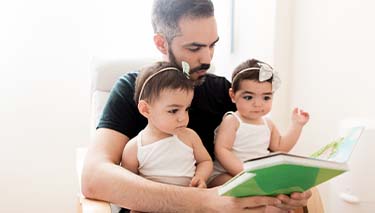The odds of having twins are far greater than for any other type of multiple births. Around 90% of all multiples are made up of twins; the remaining 10% is with triplets, quadruplets and very occasionally quintuplets and more. In recent years there has been a big increase in the numbers of twins being born. This is due to advancing maternal age, assisted reproduction technology, as well as the use of fertility drugs. Importantly, better neonatal care has meant that premature twins have a better chance of survival than ever before.
There are two types of twins – identical or monozygotic (one egg), and non-identical or dizygotic (two eggs) twins. Other names for identical twins are non-fraternal twins, and non-identical twins are sometimes called fraternal twins.
It is thought that twin pregnancies are far more common than we are aware of – perhaps as many as 5% of all pregnancies at 12 weeks involve a twin. Though not all will continue to develop as they need to in order to form two babies. Most commonly, this is thought to be due to a major interruption occurring with healthy cell maturation and division.
How do identical twins happen?
Identical twins form when one egg has been fertilised by one sperm and the zygote splits into two. This happens at the very earliest stage of development, when the zygote is no more than a cluster of a few cells. Dividing this early in conception means that each baby has exactly the same genetic information as the other.
Identical twins can also occur when one a woman has undergone fertility assistance and has had one fertilised egg returned to her uterus. If this egg then splits into two, an identical twin pregnancy can result.
Identical twins are not dependent on race, country or ethnicity. The odds of having identical twins are the same for every couple, in every pregnancy, wherever they live in the world.
Around one in every three sets of twins born is identical, and the remaining 2/3 is of the non-identical variety.
What increases the odds of having identical twins?
- Luck needs to be on your side. Identical twins do not run in families and can happen for any couple with any pregnancy. Non-identical twins are influenced by genetics; women whose mothers or grandmothers had non-identical twins do have more chance of having non-identical twins themselves. But identical twins are just random.
- Some families do seem to have a higher than average number of identical twins. Though this can only be contributed to luck, coincidence and chance rather than any familial genetic tendency.
How do non-identical twins happen?
Non-identical twins are uniquely separate individuals who just happen to be gestating at the same time and place as each other. Non-identical twins form from two completely separate eggs which are fertilised by two completely separate sperm. These fraternal twins are no more alike than any other siblings in a family with the same biological mother and father.
Because identical twins share the same genes, they are always the same gender. But non-identical twins may be the same gender or the opposite because they only share 50% of the same genetic coding.
Some people still believe that the incidence of having twins skips a generation but this is not true.
What increases the odds of having non-identical twins?
- Advancing maternal age. Women who are aged in their 30’s and 40’s have significantly higher chances of conceiving with twins. Younger women, especially those aged in their 20’s, do not have as much chance.
- Having assisted reproductive technology, in particular taking medication which increases ovulation. This makes perfect sense because the more eggs which are supported towards maturity each month, and which are then released, means the more that are available to be fertilised.
- The more pregnancies a woman has already had, the higher her chances of conceiving with non-identical twins.
- If a woman is a fraternal-non-identical twin herself, if she has siblings who are fraternal twins or her mother/grandmother had fraternal twins, then she is more likely to as well.
- Race – Black African women are more likely to have twins than women from any other ethnic descent.
What causes the fertilised egg to separate into two?
The exact reason why this happens is still a mystery. Over the years there has been a lot of research and time invested into finding out why some zygotes split into two and others don’t. But the truth is we still do not know why.
In reality, the splitting of one fertilised egg is a malformation of the natural processes of conception.
When are identical twins actually formed?
Though all identical twins are formed very early in pregnancy, there is some variation in exactly how early the fertilised egg splits into two. This can happen at the two cell stage on Day 2, the early blastocyst stage on Day 4, or in the late blastocyst stage on Day 6. The stage when the egg splits into two will determine where the fertilised eggs will implant in the uterine wall. Once the embryo gets to the 8 cells stage the foetal DNA takes over.
The stage at which the egg splits will also determine if the babies have their own amniotic membranes and placenta or if they share. Essentially, the earlier the egg splits, the more independent each twin will be by having their own amnion, chorion and placenta.
Early splitting also means that the twins are perhaps less identical than those who separate at the late blastocyst stage. Around a quarter of all identical twins are said to be mirror images of each other. This means that the left side of one twin exactly matches the right side of the other. How amazing is that!
Although identical twins share the same DNA and genetic coding, they are still unique little individuals. Small differences separate them and although at birth they can appear like little clones of each other, they are far from it. As identical twins grow, their unique qualities (particularly in relation to their personalities) become more apparent. The environment in which they are raised as well as their own personalities help to shape the adults they will become. This is exactly the same as any other baby born the world over.
How will I know if I’ve conceived with twins?
Because the splitting of the zygote occurs so early in pregnancy, mothers are not initially aware they have conceived with twins. It's not until twins may be suspected because of the intensity of pregnancy symptoms, or if they have been diagnosed through ultrasound, that a couple may know they are expecting twins.
Is it obvious at birth that twins are identical?
Even at birth it can be difficult to be sure if twins are identical or non-identical. Identical twins can still be born with their own set of membranes and this is not a marker for them to be non-identical. It’s not always clear simply by looking or examining the twins to know if they are identical or not.
The only way to be 100% sure is to do DNA testing on each twin and see what genetic information they share. This can be done in the early neonatal period by taking a swab of tissue from inside each baby’s cheek. This is painless and non-invasive.
The other way to check is to take a blood test and do blood grouping. Identical twins will share the same genetic information so the same genetic markers can be identified. Whereas non-identical twins can be very different; much the same as any other siblings with the same parents. They share around half the same genetic information and traits with each other.
What are the risks of having identical twins?
- If the identical twins share a placenta they are at a higher risk of having twin-to-twin transfusion syndrome. This often results in one twin gaining more nourishment than the other, and having a higher birth weight as a result.
- Umbilical cord entanglement and compression if the twins share an amniotic sac. Purely because of the crowded conditions which occur in the mother’s uterus.
With identical and non-identical twins, there is an increased risk of pregnancy and birth complications. There is also an increased likelihood of prematurity and associated problems.
Last Published* May, 2024
*Please note that the published date may not be the same as the date that the content was created and that information above may have changed since.



















